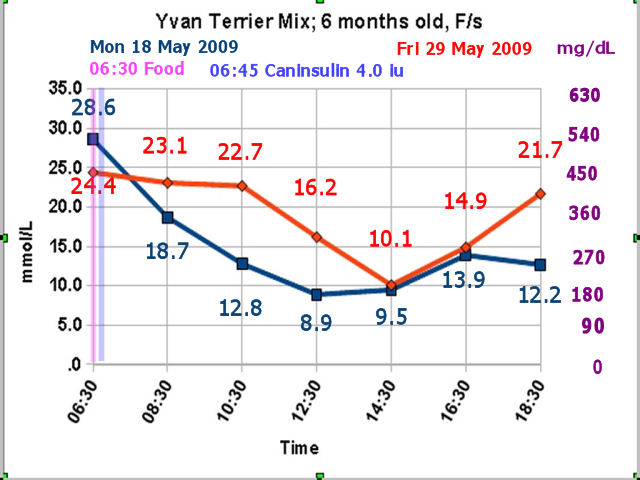Last updated: Mon, 8 Jun 2009 16:58:08
It is now Sun, 19 Sep 2010 03:08:51
Last updated: Mon, 8 Jun 2009 16:58:08
It is now Sun, 19 Sep 2010 03:08:51

[cx10205bg-yvan090529c3.jpg] Yvan - two curves
Yvan was spayed on 20 May 2009, and I'm delighted to report that she came through the spay beautifully, healing up as well as a dog without diabetes would do.
Also, note how she is stabilizing in the blood glucose levels, still on a dose of 4.0 iu (International Units) of Caninsulin, which, you may remember, is exactly the same stuff as Vetsulin.
To make it easier to follow progress in a dog featured here, I am adding a kind of tracking list, which merely links to other charts for the same dog.
It seems generally agreed among veterinarians that female dogs diagnosed with diabetes should be spayed as early as possible, to allow the greatest possible stability in hormone levels. Spaying helps protect against erratic changes in blood glucose levels that might threaten hypoglycemic episodes, just for instance.

[cx10206-yvan090529c1.jpg] Yvan's data table, 18 and 29 May 2009
Yvan's first two curves were frightening, with rebound evident. Her veterinarian kept the Caninsulin dose constant, to date (29 May 2009), and it is a huge relief now to see how much more stable her blood glucose levels are by the time of this 29 May 2009 curve.
Yvan's HumanMum reports she is lively and well.
The next step is to work to bring the higher levels down, without allowing levels that are too low for safety. Potential blindness is a concern, and keeping the levels below about 13.8 or 14.0 mmol/L (or, 250 mg/dL) would help slow the development of diabetic cataracts.
The latest news is that Yvan's HumanMum is about to acquire an AlphaTrak glucometer, and, with the help and support of Yvan's veterinarian, she will be learning to test Yvan's BG levels.
It does take a bit of practice to learn to test, but Yvan's HumanMum will surely learn, as do many of those whose veterinarians support having the Human DogParents do the testing.
Typically, Human DogParents who learn to do this share the results with their vets, who then make any recommendations for changes in insulin dose. Also, it's a great safeguard for the dog, when the HumanParent can monitor the blood glucose levels. Then if there's any possibility of a hypoglycemic episode showing up, the human can take steps to prevent that, often, by giving an appropriate snack. Eventually, the insulin dose may need changing as well.


